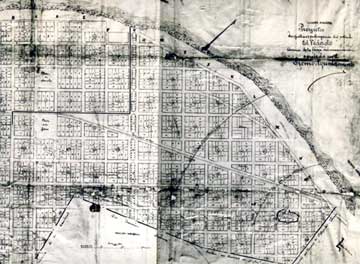Looking for a casa particular in the Vedado? Take a look here, you'll find the complete list of what we're offer.
The Rare History of El Vedado
Tourists when they hear about The Vedado accept the name without question, very few of them know what it really means. In reality either the name than the history of Vedado hide strange and adventurous origins.
Why the name of Vedado si so strange? What is its history?
In English it is just a Spanish name. But in Spanish, the world vedado is very strange. History is boring for some people but I will try to keep it cool or at least interesting. In a colonial epoch, when the only center of Havana City was the now called Old Havana, because at that time it was young, the area corresponding to what now is Vedado was a very thick wood, which covered all the included zone between the Cerro borough to the Malecón littoral, from the El Morro Fortress to the La Chorrera river, today Almendares river. The wood very thick of vegetation and precious wood trees.
The term "vedado" in Spanish means "forbidden", "not allowed". So, this wood was a forbidden zone. Why? In fact, the colonial government forbid any construction or urbanization in this area, because the wood was an excellent protection against invasions coming from the sea, say pirates. Today, a portion of this wood still remains and surrounds the Almendares river and it is called Bosque de La Habana (Havana Wood).
A wood that divides two residential zones and the downtown
El Bosque de La Habana is one of the most singular places of Havana, in fact, very few cities have a wood dividing the center from its residential zones (I'm talking about Miramar and Nuevo Vedado).
The Vedado: From frozen zone to an urbanism masterpiece
Nobody would imagine at that epoch that a wood, where it was forbidden to build, not only would turn into the «Manhattan of Cuba», but also it would be a masterpiece of urbanism, a classic of the modern city design, so different than Old Havana, and this was maybe due to the relatively late time of its construction.
In fact, in the middle of the IXX century, the interdiction to build in the area no longer made sense and the city needed an expansion. Then, in 1859 an urbanization project was filed. The author was Luís Iboleón, a civil engineer about who we know almost nothing today, but who left a tremendous legacy. In fact, El Vedado seems to be popped up from magic, being an urban work that every town planner dreams to achieve.
In the picture you can see the original urbanization project of the El Vedado neighborhood and you can appreciate that today the actual district remains almost unchanged.
Development of El Vedado
The urbanization and occupation of Vedado, as it looks obvious, was slow and progressive, but at the middle of the 1880 decade it already had about 30 blocks inhabited, most of them at the north of Línea avenue. Nevertheless, it seems that the first urbanized streets were Calzada (or Calle Séptima) and the 17th Avenue.
Cuba was the first country of Latin America to have the tramway and the first one was built in the Vedado, exactly in the Línea Avenue, called at that time Wilson Avenue. This street has the particularity to cut the neighborhood's blocks diagonally, from its inception, The Malecón, up to D Street, the exact spot where it becomes "straight" again and this make it the perfect shortcut for tramways implementation, due of its lower costs. For this, the avenue was not longer called Wilson and began to be called Línea! Today the tramway doesn't exist anymore, but the street kept its name and prestige.
Contrary to other municipalities of Havana, most streets of El Vedado are named by letters and numbers, as we have seen, according to the americanizing tendency of that time. The El Vedado is buit above a long hill or a little plateau. This is maybe its major drawback, because it makes it difficult to moving by walk or no-motorized means between a zone and another, especially between the upper and the lower part.
Starting from the XX century, the Vedado was the theater of great mansions, it was where aristocracy lived. But, since the beginning of the 1930s up to the Second World War, rich people began to move towards Nuevo Vedado or Miramar, following the trend of the epoch.
El Vedado lost its value at first, but it took it back quite fast, because during the 1950's it has a tremendous development until it became the heart of Havana. Fabulous hotels, high building and other night life institutions were built converting El Vedado to the most modern zone of the city.
With the victory of the Cuban Revolution, El Vedado was already totally delimited and its development brought it to be the modern downtown as we know it today.
Attractions of El Vedado
The place with most life in the Vedado has always been the zone called La Rampa, which begin with the 23 and L crossroads and it ends directly in the Malecón. According to some people, this zone is considered the true Downtown of Vedado.
It is there where most of the agencies are found, a great craft bazaar, the Pavillon of Cuba which is another great bazaar, the Coppelia ice cream shop which, years ago, made the best ice crams of Cuba, the Meliá Tryp Habana Libre Hotel, a bunch of few other hotels and plenty of bars and restaurants. In sum, the Mecca of the entertainment, at least at daytime, because at night, La Rampa has lost a lot of its prestige.
Nevertheless for a heathier nigh life, we'd better recommend the zone delimited from the G Avenue (or Presidents Avenue), to the Paseo Avenue, where you'll also find the Meliá Cohiba and Iberostar Habana Riviera hotels. This zone is much better. Also the Piragua is another place of entertainment, just beside the National Hotel of Cuba, but it's not a big place neither, because it's very close to La Rampa.
But El Vedado is not only suitable to have fun. It also has a lot of interesting and cultural places. Most of the big mansions whose owners emigrated in the United States during the 1960' became museums, historic or cultural places and so on. Therefore the Old Havana is not the only place you should visit for this kind of things.
Among the cultural interesting places we can mention some of them, like the National Theater, the Mella Theater, the Bertold Brecht Theater and Concert room, the Amedeo Roldán classical music hall, The House of the Dance, the Napoleonic Museum, the America's House, the House of UNEAC, the University of Havana, Havana Gallery and the House of the Culture of Plaza, which hosts the International Jazz Festival each two years. And finally the Colón Cemetery is not a simple cemetery. It's a monument of considerable historic, aesthetic, cultural and artistic values. Even the inside streets are a master piece of urbanism, visited every day from tourists from everywhere.
Conclusion
El Vedado is almost as interesting to visit as Old Havana. In order to know and visit all the mentioned places and others, just consult any tourist's guide. In the airport itself, you will find several of them for free with maps and informations not only about Vedado but also about Havana City and any other zone of Cuba. There are also many 13-Nov-25Info Tours all along Cuba where you can find a lot of useful information without having to buy an expensive magazine in your country!









